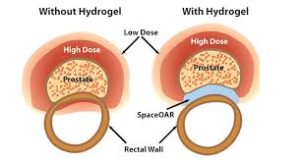 Prostate cancer is the most common non-skin cancer diagnosed in men.
Prostate cancer is the most common non-skin cancer diagnosed in men.
Radiation therapy is an excellent treatment option for prostate cancer, however, it can cause bowel side effects.
Hydrogel spacers are designed to reduce bowel injury by providing a space between the rectum and the prostate.
Hydrogel refers to hyalouronic acid spacer.
Hydrogel spacers also reduce urinary and sexual symptoms.
These spacers are used for most prostate cancer patients treated with external beam radiation or seed implants.
Hydrogel spacers are an absorbable gel that temporarily creates a space between the prostate and the rectum.
Hydrogel spacer benefits:
Reducrs the harmful effects of radiation therapy
Allows for improved targeting
Allowing for higher doses of radiation to improve chance of cure
Allowing for a shorter treatment time with SBRT
Placement of hydrogel spacers is a minimally invasive outpatient procedure.
Local anesthesia is used, with a single needle placed in the space between the prostate and rectum injecting a water based agent.
The agent quickly expands and solidifies into a gel.
Most patients experience minimal or no side effects following procedure.
Markers may also be placed in the prostate to help with radiation delivery.
The gel remains in place during radiation treatment, and is naturally absorbed by the body within six months.
The gel is filtered by the kidneys and leaves nothing behind in the body.
The improvement in bowel, urinary and sexual quality of life is 8 times more than patients without hydrogel spacers.
Bowel: 66% fewer hydrogel spacer patents experienced bowel symptoms.
Urinary: 65% fewer hydrogel spacer patients experienced urinary symptoms.
Sexual: Hydrogel spacer patients who had good erectile function prior to treatment were 78% more likely to retain sexual function at 3 years.
The use of hypo fractionated radiation therapy for treating prostate cancer. It has increased substantially and it’s used ranges from 50 to 85% of centers.
Hypofractionated radiation therapy is associated with a greater than 9% risk of acute grade 2 or higher G.I. toxic affects compared with conventional fractionated radiation therapy, the use of a hyaluronic acid rectal spacer should be considered in patient receiving hypo fractionated radiation therapy for prostate cancer.
